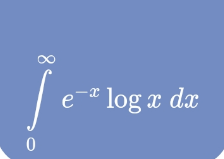
Question and Answers Forum
IntegrationQuestion and Answers: Page 122







Pg 117 Pg 118 Pg 119 Pg 120 Pg 121 Pg 122 Pg 123 Pg 124 Pg 125 Pg 126
|
Question and Answers Forum |
IntegrationQuestion and Answers: Page 122 |
| ... advanced math ... two simple and nice integrals: prove that:: Ω_1 =∫_0 ^( ∞) ((sin(e^(−γ) x)ln(x))/x) dx=0 Ω_2 =∫_0 ^( ∞) ((sin(x^((√2)/2) )ln(x))/x)dx=−πγ note :: γ : Euler−mascheroni constant. .m.n. |
| ∫ (dx/( (√((x−a)(b−x))))) ? |
| Evaluate the integral ∫ (((x)^(1/3) +1)/( (x)^(1/3) −1)) dx |
| ...nice integral... prove that :: ∫_0 ^( ∞) cos(πnx)((1/x^2 )−((πcoth(πx))/x))dx =^(???) πln(1−e^(−πn) ) .m.n. |
| ...nice calculus... In AB^Δ C prove :: ∗: sin((A/2))sin((B/2))sin((C/2))≤(1/8) ......................... ∗∗:: max(cos((A/2))cos((B/2))cos((C/2)))=? |
| solve ∫_((a−1)^2 ) ^a^2 cosh^(−1) (1/( (√(a−(√x))))) dx with a>0 |

|
| ... advanced integral... i: ∫_0 ^( 1) ((1/(ln(x)))+(1/(1−x)))dx=γ ii: ψ(x)=∫_0 ^( ∞) ((e^(−t) /t) −(e^(−tx) /(1−e^(−t) )))dt solution :{_(2 : ln(n) =^(easy) ∫_0 ^( 1) ((x^(n−1) −1)/(ln(x)))dx (∗∗)) ^(1: H_n = Σ_(k=1) ^n (1/k) =∫_0 ^( 1) ((1−x^n )/(1−x)) dx (∗)) (∗)−(∗∗): H_n −ln(n)=∫_0 ^1 (((1−x^n )/(1−x)) −((x^(n−1) −1)/(ln(x))))dx lim_(n→∞) (x^n )=^(0<x<1) 0 lim_(n→∞) (H_n −ln(n))=∫_0 ^( 1) ((1/(1n(x)))+(1/(1−x)))dx γ= ∫_0 ^( 1) ((1/(ln(x)))+(1/(1−x)))dx ✓ ............................. ψ(x)=^(easy) −γ+∫_0 ^( 1) ((1−t^(x−1) )/(1−t))dt ψ(x)=−∫_0 ^( 1) (1/(ln(t)))+(1/(1−t))dt+∫_0 ^( 1) ((1−t^(x−1) )/(1−t))dt =∫_0 ^( 1) −(1/(ln(t))) +((1−t^(x−1) −1)/(1−t))dt =−∫_0 ^( 1) (1/(ln(t)))+(t^(x−1) /(1−t)) dt=^(t=e^(−y) ) =−∫_∞ ^( 0) ((1/(−y))+(e^(−yx+y) /(1−e^(−y) )))(−e^(−y) )dy =∫_0 ^( ∞) (e^(−y) /y)−(e^(−yx) /(1−e^(−y) ))dy ∵ ψ(x)=∫_0 ^( ∞) ((e^(−y) /y)−(e^(−yx) /(1−e^(−y) )))dy ✓ |

|
| Find the arc length of the curve x=(1/4)y^2 −(1/2)ln (y) between the points with the ordinates y=1 and y=2. |
| ∫_1 ^(16) arctan (√((√x) −1)) dx ∫_0 ^(π/2) sin (2x) arctan (sin x) dx |

|
| any one can explain me about Fresnel integral ? |
| ∫_0 ^3 (√(1+cos (x^2 ))) dx ? |
| ...nice calculus... Ω =∫_0 ^( (π/2)) xsin(x).cos(x)ln(sin(x).ln(cos(x))dx =^(???) (π/(16))−(π^3 /(192)) ✓ |

|
| V=∫_0 ^3 ((x dx)/( (√(x+1))+(√(5x+1)))) T=∫_(−π/2) ^(π/2) (√(cos x−cos^3 x)) dx |

|
| ∫ (x/((x^2 +a^2 )(x^3 +b^2 ))) ? |

|
| ∫ (x^3 /( (√(4−x^2 ))+x^2 −4)) dx |
| a\∫((2x+1)/(1+x))(√((1−x)/(1+x)))dx c\∫(dx/( (√x)+(x)^(1/3) )) b\∫(dx/(x+(√(x−1)))) d\∫(dx/( (1+x)(√(1+x+x^2 )))) |

|
| Find the polynomial P(x) of least degree that has a maximum equal to 6 at x=1 and minimum equal to 2 at x=3. |
| ...advanced calculus... prove that : Re(∫_0 ^( (π/2)) sin^3 (x)ln(ln(cos(x)))dx) =^? ((ln(3)−2γ)/3) ✓ |
| calculate A_n =∫_0 ^∞ (dx/((x^2 +1)(x^2 +2)....(x^2 +n))) wth n integr natural and n≥1 |
Pg 117 Pg 118 Pg 119 Pg 120 Pg 121 Pg 122 Pg 123 Pg 124 Pg 125 Pg 126 |